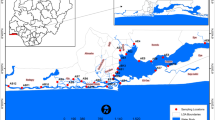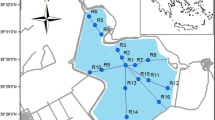Abstract
This paper deals with the assessment of the available insoluble calcium compounds in pond sediment and their conversion into soluble bicarbonate; its impact on the acid neutralizing capacity (ANC) or alkalinity of water and the influence of bioturbation by fish stock. The objective of the study was the assessment of the influence of different Ca contents in pond sediments of two groups of ponds: LCa (with a low content of available Ca) and HCa (with a high content of available calcium) on acid neutralizing capacity of water, conductivity and pH. In our experiments, the turbidity of water, content of chlorophyll, nutrients and natural gain of fish in general have been observed as well. The results revealed that ponds with a higher content of calcium with a mean concentration of 27.45 ± 7.9 mmol Ca/kg in dry matter reported a higher ANC (alkalinity; mean value of 2.31 ± 0.33 mmol/l); pH with smaller fluctuations (7.69 ± 0.37; p < 0.05) and higher average values of turbidity (30.9 ± 17.4 NTU) and conductivity of water (291 ± 40.5 μS/cm−1; p < 0.01). Tight relations of the content of Ca in sediments and acid neutralizing capacity, conductivity and water pH during the growing season have been proven. The natural gain of fish was higher in the ponds with a higher content of available Ca in the sediment and a higher value of acid neutralizing capacity of water. The natural gain of fish was positively influenced also by a higher content of nutrients and chlorophyll, which was observed particularly in HCa ponds.


Similar content being viewed by others
References
Adamek Z, Marsalek B (2013) Bioturbation of sediments by benthic macroinvertebrates and fish and its implication for pond ecosystems: a review. Aquac Int 21:1–17
Adámek Z, Helešic J, Maršálek B, Rulík M (2010) Hydrobiological foundations of fishpond management. In: Applied hydrobiology. Vodňany FROV JU, 309–332
Adamek Z, Linhart O, Kratochvil M, Flajshans M, Randak T, Policar T, Masojidek J, Kozak P (2012) Aquaculture the Czech Republic in 2012: modern European prosperous sector based on thousand-year history of pond culture. Aquaculture Europe 37(2):5–14
Bauer Ch (2014) Waldviertel Teiche, Ökologische Station Waldviertel, Schrems, Denisia 33. OÖ Landesmuseum, 157–166
Boyd CE (2000) Water quality: an introduction. Kluwer Academic Publishers, Boston, MA USA, p. 330
Boyd CE, McNevin A (2015) Chemicals in Aquaculture. In: aquaculture, resource use, and the environment. Published by John Wiley & Sons, Inc., Hoboken, New Jersey, pp. 173–210
Boyd CE, Scarsbrook E (1974) Effects of agricultural limestone on phytoplankton communities of fish ponds. Arch Hydrobiol 74:336–349
Boyd CE, Tucker CS (1998) Pond aquaculture Watter quality management. Kluwer Academic Publishers, Boston, MA USA, p. 700
Boyd CE, Wood WC, Thunjai T (2002) Aquaculture pond bottom soil quality management. Pond Dynamics/Aquaculture Collaborative Research Support Program Oregon State Univerzity, Oregon, p. 41
Drbal K, Bastl J (1988) Determination of an alkali reserve in pond sediments. Working manual. University South Bohemia, České Budějovice
Füllner G, Pfeife M, Langner N (2007) Karpfenteichwirtschaft. Bewirtschaftung von Karpfenteichen. Karbondüngung, Kalkung, Sächsische Landesanstalt für Landwirtschaft, Referat Fischerei, Königswartha, pp. 48–60
Ghanbari M, Jami M, Doming KJ, Kneifel W (2012) Long-term effects of water pH changes on haematological parameters in the common carp (Cyprinus carpio L.). Afr J Biotechnol 11(13):3153–3159
Guziur J, Bialowas H, Milczarzewicz W (2003) Fish farming in ponds (Rybactwo stawowe). Nawoženie stawów. Oficyna Wydawnicza “Hoža”, Warszawa, pp. 292–298
Hartman P (1992) Assessing of liming ponds in relation to environmental conditions, Dissertation, Mendel University Brno
Hartman P (2004) Considerate method of pond liming. In: Metodika VÚRH Vodňany vol 73, VÚRH Vodňany
Jamu DM, Msiska OV (1996) Liming of fish ponds in Malawi: a comparative study of limed and unlimed ponds. In: Pulin RSV, Lazard J, Legendre M, Amon-Kothias JB and Pauly D (eds). Liming materials function primarily to elevate pH, alkalinity and carbon availability in pond waters and raise the pH of bottom soil and enhance phosphorus solubility and organic matter decompositio, The third international symposium on tilapia in aquaculture. ICLARM Conference Proceedings, 575
Janeček V and Přikryl I (1982) Growing of stock and market carps in intensive growing ponds. In: Metodika VÚRH Vodňany vol 2, p.16.
Kainz E (1998) Productionsverhältnisse und Lebensbedingungen im Fischteich. In: Schäperclaus W, Lukowicz M (eds) Lehrbuch der Teichwirtschaft 4. neubearbeitete Auflage. Parey Buchverlag, Berlin, pp. 157–185
Kainz E and Schwarz K (1986) Chemische, biologische und fischereiliche Untersuchungen an mehreren Waldviertler Karpfenteichen. Wissenschaftliche Mitteilungen NÖ Landesmuseum, vol 4. Wien, 43–210
Lermann A, Stumm W (1989) CO2 storage and alkalinity trends in lakes. Water Res 23(2):139–146
Pechar L (2000) Impacts of long-term changes in fishery management on the trophic level water quality in Czech fish ponds. Fish Manag Ecol 7:23–31
Pitter P (2009) Hydrochemistry, 4th revised edn. VŠCHT, Praha, pp. 230–254
Ritvo G, Kochba M, Avnimelech Y (2004) The effect of common carp bioturbation on fishpond bottom soil. Aquaculture 242:345–356
Schejbal P (2003) Kyselinová neutralizační kapacita vody. In: Horáková M et al (eds) Analytika vody. Textbook. VŠCHT, Praha, pp. 82–87
Schreckenbach K (2004) Kiemenerkrankungen und Ernährung bei Karpfen, Berlin. Fischer und Teichwirt 45(1):16–18
TG-Service, Teichgenossenschaft Aischgrund (2016) Teichkalkung, Wasseranalytik, Feststellen der Wasserchemie. http://www.karpfenland-aischgrund.de/?TGService:Fachliches
Thunjai T, Boyd CE, Boonyaratpalin M (2004) Quality of liming materials used in aquaculture in Thailand. Aquac Int 12:161–168
Wurts WA, Masser MP (2004) Liming ponds for aquaculture. Southern Regional Aquaculture Center, Kentucky State University Cooperative Extension, Kentucky 2004. SRAC Publication No. 4100
Acknowledgements
The study was financially supported by the Ministry of Education, Youth and Sports of the Czech Republic—projects, “CENAKVA” (No. CZ.1.05/2.1.00/01.0024) and “CENAKVA II” (No. LO1205 under the NPU I program).
Author information
Authors and Affiliations
Corresponding author
Additional information
Guest editors: Zuzana Linhartová and Jan Mráz / Carp pond aquaculture, product processing and quality.
Electronic supplementary material
ESM 1
(XLSX 14 kb)
Rights and permissions
About this article
Cite this article
Hartman, P., Kutý, M., Hlaváč, D. et al. Calcium content in pond sediment and its effect on neutralizing capacity of water and fish production. Aquacult Int 24, 1747–1754 (2016). https://doi.org/10.1007/s10499-016-0087-9
Received:
Accepted:
Published:
Issue Date:
DOI: https://doi.org/10.1007/s10499-016-0087-9




